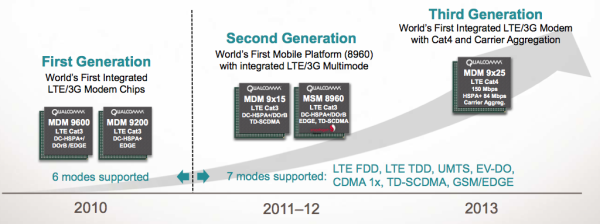Preparing for the iPhone Next: Rumors Analyzed
by Brian Klug & Anand Lal Shimpi on August 27, 2012 9:40 PM EST- Posted in
- Smartphones
- Apple
- Mobile
- iPhone
Cellular Connectivity: LTE Expected
The iPhone has always used separate applications and baseband processors. The next model is not expected to be any different. The big addition with the upcoming iPhone will be a massive and much needed improvement in cellular connectivity. Put simply, the addition of both support for LTE in the Americas and perhaps a few other international markets, and TD-SCDMA support for China. Support for LTE is simply requisite for a high end smartphone at this point, and inclusion of TD-SCDMA is likewise requisite for any further growth in China.
The commercial availability of Qualcomm's second generation Gobi modems and transceivers will make this possible without the design caveats posed by the previous generation of LTE basebands. Specifically, caveats such the lack of a built in codec for voice, requiring the so-called Qualcomm SoC fusion scenario that required MDM9x00 to ship in conjunction with a Qualcomm SoC to enable voice (whereas MDM9x15 is natively voice enabled). That's to say nothing of power draw which improved over time for MDM9x00 with software improvements (such as inclusion of more DRX features), but still precluded inclusion in an iPhone without a battery penalty. There's a reason you see MDM9x00 in the iPad 3 with WiFi but not in the iPhone 4S, even though it was available for that product's release.
The part we've fingered for baseband in the next iPhone is Qualcomm's MDM9x15 platform, which is a 28nm TSMC device that includes support for Category 3 LTE TDD and FDD, up to Release 8 42 Mbps DC-HSPA+, GSM/EDGE, TD-SCDMA, and CDMA2000 1x, 1xAdvanced, and EVDO on the MDM9615 variant. This is the same IP block as what is already inside shipping MSM8960 SoCs and devices today, where we've seen great battery life and LTE performance. There's one further improvement as well which MDM9615 hopefully will have over the current MSM8960 implementation, and that's the inclusion of a new 28nm RF (as opposed to logic) transceiver named WTR1605, instead of the 65nm RTR8600. This new transceiver also includes even more ports (7 instead of 5 on RTR8600) which means we will see likely more 3G or 4G LTE bands supported in this upcoming device. Even without that improvement we'll see inclusion of LTE without any caveats.
Because 2x2 MIMO is mandatory for LTE Category 2 and above (and 2 receive diversity mandatory for all LTE categories), you can see how that top bottom RF window and antenna split we touched on earlier makes even more sense. Again, this isn't a big leap from the iPhone 4S which already features both receive and transmit diversity split between top and bottom antennas, but just further fits into the LTE iPhone puzzle.
A small note under the cellular category is that this will also likely continue to be where GNSS (GPS and GLONASS) resides, something the CDMA iPhone 4 and 4S both already have courtesy the MDM66x0 baseband inside. MDM9x15 bumps this slightly, from Qualcomm's GPSone with GLONASS generation 8 to 8A, though I'm not certain what all improvements come from that change in version.












131 Comments
View All Comments
KoolAidMan1 - Tuesday, August 28, 2012 - link
Unless you're a Linux using neckbeard (and I'd bet money that you aren't), then your entire post is trash.And if you are a Linux using neckbeard, sucks to be you
Focher - Tuesday, August 28, 2012 - link
Funny that each generation of iPhone is just an upgrade to all the previous generation iPhone owners. Of course, we wouldn't want math to get in the way of that assertion so let's just assume every iPhone owner will buy at least two of the next version. Some even more!Also interesting is your claim that the article is based on conjecture after two whole paragraphs of exactly that which you disdain. By the way, I would suggest you look up that word in a dictionary. Because an article that analyzes leaked pictures of the hardware and then makes predictions based on those items doesn't at all fit the definition of that word.
inplainview - Wednesday, August 29, 2012 - link
Obviously someone has given you the impression that your purchasing decisions matter to the masses. No one really cares what you will and will not buy.Super56K - Friday, August 31, 2012 - link
I love these posts. It gives the vibe of someone standing on a street corner holding a 'THE WORLD IS ENDING' sign; giving the same spiel, over and over, to anyone who makes eye contact.solipsism - Tuesday, August 28, 2012 - link
If by tweak, you mean completely redesigned, then yeah.ramnam - Monday, August 27, 2012 - link
Would using a backplate made of the liquidmetal stuff mitigate concerns about it acting as a ground for the NFC field ? I understand Apple licensed the technology a while backjrswizzle - Tuesday, August 28, 2012 - link
This is an on-again, off-again rumor I hope comes to pass. Though the head of the company who produces the liquid metal said it would be years before they'd be able to produce the stuff on the mass scale needed for a device like the iPhone to be made of it.swb311 - Tuesday, August 28, 2012 - link
Several years away unfortunatelyjwcalla - Monday, August 27, 2012 - link
If true it's a rather conservative update at a time when the competition is getting pretty fierce. You can't be too risk-averse in this business.jjj - Monday, August 27, 2012 - link
there is a bigger screen there so battery life might not be any better.as for the SoC,they mgiht go for dual A9 (they certainly won't go quad) but that's so far behind the top phones that they really should do more.
The iPhone is the new dumbphone but still quad Krait vs dual A9, is just lol.